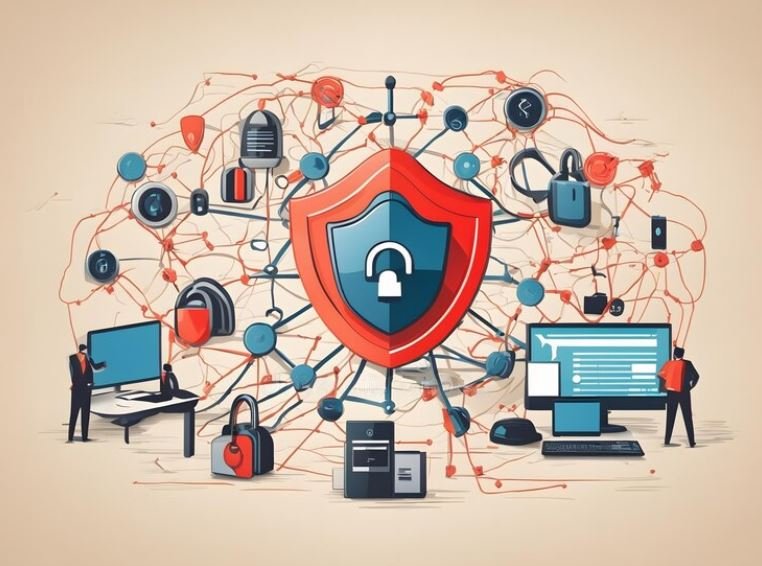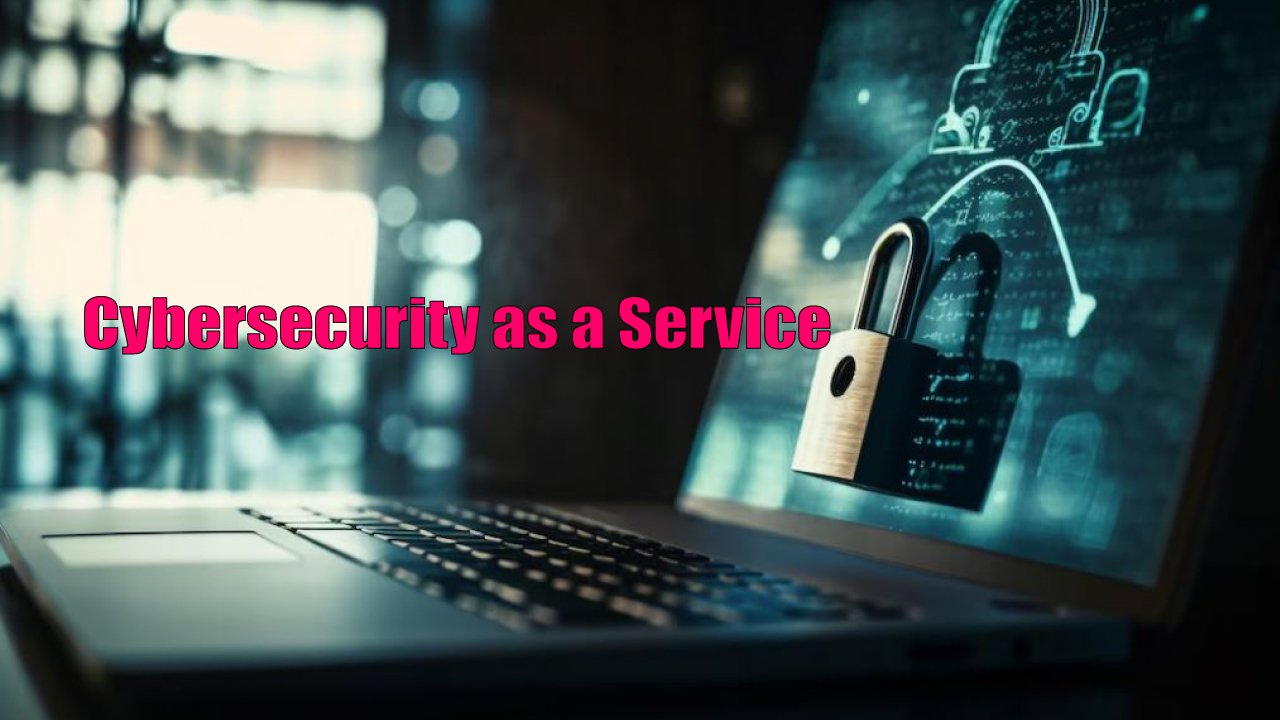Introduction
In today’s digital world, cybersecurity is more important than ever before. Businesses of all sizes are at risk of cyberattacks, which can have devastating consequences. Cybersecurity as a Service (CSaaS) is a solution that can help businesses protect themselves from these threats.
What is Cybersecurity as a Service?
Cybersecurity as a Service (CSaaS) is a model in which organizations outsource their cybersecurity needs to a third-party service provider, who delivers a range of cybersecurity services and solutions on a subscription basis. This approach allows businesses to access expert cybersecurity capabilities and tools without the need to build and maintain an in-house cybersecurity team or infrastructure. Others have explained this.

Key aspects of Cybersecurity as a Service include:
1. Security Services:
CSaaS providers offer a variety of security services, such as threat detection and monitoring, incident response, vulnerability assessment, penetration testing, and more. These services are typically tailored to the specific needs and size of the client organization.
2. Cloud-Based Solutions:
Many CSaaS offerings are cloud-based, which means the security tools and services are hosted and managed in the cloud. This approach provides scalability and flexibility, allowing organizations to adapt to changing security needs.
3. Subscription Model:
CSaaS is typically provided on a subscription or pay-as-you-go basis, making it more cost-effective for many organizations. Clients can choose from different service tiers based on their requirements.
4. Expertise and Resources:
CSaaS providers are often staffed with cybersecurity experts who continuously monitor and respond to threats. They have access to the latest threat intelligence and technologies, providing clients with a higher level of protection.
5. Regulatory Compliance:
CSaaS providers may help clients meet regulatory compliance requirements by implementing security controls and processes that align with industry standards and regulations.
6. Managed Security:
In some CSaaS models, the service provider takes on the role of managing and maintaining the security infrastructure and tools, allowing the client organization to focus on its core business functions.
7. Continuous Improvement:
Cybersecurity is an ever-evolving field. CSaaS providers stay up-to-date with emerging threats and technologies, ensuring that clients receive the most current and effective protection.
CSaaS can be particularly beneficial for small and medium-sized businesses (SMBs) that may lack the resources to build a comprehensive in-house cybersecurity program. It also suits larger organizations looking to augment their existing security efforts or address specific security gaps. Apart from this, you can visit our site to know other things.
Benefits of Cybersecurity as a Service
There are many benefits to using CSaaS, including:
Expertise and Access to Skilled Professionals:
CSaaS providers typically employ experienced cybersecurity experts who are well-versed in the latest threats and security best practices. This access to expertise can be especially valuable for organizations that lack an in-house cybersecurity team.

Cost-Efficiency:
CSaaS is often provided on a subscription or pay-as-you-go basis, which can be more cost-effective than building and maintaining an in-house cybersecurity infrastructure. It allows organizations to budget for cybersecurity services without the capital expenditures associated with buying and maintaining hardware and software.
Scalability:
CSaaS solutions can easily scale with an organization’s evolving needs. Whether a business is growing or downsizing, CSaaS providers can adjust the level of service to match the changing threat landscape and requirements.
Rapid Deployment:
CSaaS offerings can be implemented more quickly than building an in-house security program from scratch. This means organizations can improve their cybersecurity defenses without significant lead time.
Access to Advanced Technologies:
CSaaS providers typically have access to the latest cybersecurity tools and technologies. They can implement and manage cutting-edge solutions that may be expensive or difficult to acquire for individual organizations.
24/7 Monitoring and Response:
Many CSaaS providers offer around-the-clock security monitoring and incident response services. This constant vigilance helps detect and respond to threats in real-time, reducing the impact of security incidents.
Regulatory Compliance:
CSaaS providers often help organizations meet regulatory and compliance requirements by implementing security controls and processes that align with industry standards and regulations.
Focus on Core Business Functions:
Outsourcing cybersecurity responsibilities to a CSaaS provider allows organizations to concentrate on their core business activities, rather than diverting time and resources to managing security operations.
Continuous Updates and Patch Management:
CSaaS providers keep security solutions up to date with the latest threat intelligence and software patches, reducing the risk of vulnerabilities being exploited.
Enhanced Threat Detection and Response:
CSaaS providers leverage their expertise and technologies to improve an organization’s ability to detect and respond to cybersecurity threats effectively.
Disaster Recovery and Business Continuity:
Many CSaaS providers include disaster recovery and business continuity planning as part of their services, ensuring that an organization can recover from security incidents and other disasters.
Customization:
CSaaS offerings are often customizable to meet the specific needs and risk profile of the client organization, allowing businesses to tailor their cybersecurity solutions.
Reduction of Human Resource Burden:
By outsourcing cybersecurity functions, organizations reduce the burden of hiring, training, and retaining cybersecurity personnel, which can be challenging in a competitive job market.
Types of Cybersecurity as a Service
There are many different types of CSaaS, including:
Managed security services:
Managed security services providers (MSSPs) monitor and manage your cybersecurity infrastructure for you.
Security information and event management (SIEM) as a service:
SIEM as a service helps you to collect, analyze, and respond to security logs and events.
Endpoint security as a service:
Endpoint security as a service helps you to protect your devices from malware and other threats.
Cloud security as a service:
Cloud security as a service helps you to protect your cloud-based applications and data.
How to Choose a Cybersecurity as a Service Provider
When choosing a CSaaS provider, there are a few factors to consider:
Determine Your Budget:
Establish a cybersecurity budget and be prepared to allocate resources for CSaaS. This budget will help you narrow down your options and ensure you select a provider that aligns with your financial constraints.
Research Potential Providers:
Conduct thorough research to identify CSaaS providers that offer the services and expertise your organization needs. You can do this through online research, recommendations from peers, industry publications, and cybersecurity forums.
Evaluate Expertise and Experience:
Examine the provider’s track record and experience in the cybersecurity field. Look for evidence of success in handling security incidents, a strong understanding of emerging threats, and a commitment to ongoing education and improvement.
Check Certifications and Compliance:
Verify that the CSaaS provider has relevant industry certifications, such as ISO 27001 or SOC 2, and complies with any specific regulatory requirements that apply to your organization.
Assess Services Offered:
Ensure that the provider offers the specific services you need, whether it’s threat detection, incident response, vulnerability assessments, penetration testing, or other cybersecurity services. Confirm that they can tailor their services to your organization’s size and requirements.
Technology and Tools:
Examine the cybersecurity tools and technologies the provider uses. They should have access to advanced security solutions and be able to provide a demonstration of their effectiveness. Make sure these tools align with your organization’s technology stack.
Data Privacy and Protection:
Verify how the provider handles and protects your data. Ask about their data encryption, data retention policies, and compliance with data privacy regulations like GDPR or HIPAA, depending on your industry.
SLAs and Response Times:
Review the provider’s Service Level Agreements (SLAs) and response times for security incidents. Ensure that they can meet your organization’s expectations for incident resolution and communication.
Customer References:
Request references from the CSaaS provider, and contact their existing clients to gather feedback and insights into their performance and customer service.
Contract Terms and Exit Strategy:
Carefully review the terms and conditions of the CSaaS contract, including cancellation policies and exit strategies. Be aware of any long-term commitments or hidden fees.
Collaboration and Communication:
Evaluate how well the provider collaborates and communicates with your organization. Effective communication and collaboration are crucial for successful cybersecurity management.
Redundancy and Reliability:
Inquire about the provider’s redundancy and reliability measures to ensure continuous service availability, especially in the event of a security incident or downtime.
Scalability:
Ensure the CSaaS provider can accommodate your organization’s future growth and evolving cybersecurity needs.
Security Policies and Procedures:
Request the provider’s security policies and procedures, such as incident response plans and breach notification processes, to assess their commitment to protecting your organization’s data.
Trial Period or Proof of Concept:
If possible, ask for a trial period or a proof of concept to test the provider’s services and evaluate their effectiveness before making a long-term commitment.
Conclusion
In conclusion, Cybersecurity as a Service (CSaaS) is a valuable approach for organizations looking to bolster their cybersecurity defenses without the need to build and maintain an in-house cybersecurity program. It offers numerous benefits, including access to cybersecurity expertise, cost-efficiency, scalability, and rapid deployment. CSaaS providers offer a range of security services, access to advanced technologies, and 24/7 monitoring and response, which collectively enhance an organization’s ability to protect against cyber threats.
Moreover, CSaaS can help organizations meet regulatory compliance requirements, focus on their core business functions, and reduce the burden of managing cybersecurity personnel and infrastructure. It provides continuous updates and patch management, disaster recovery and business continuity planning, and customization to suit the unique needs and risk profile of each client.
However, while CSaaS offers numerous advantages, organizations should approach the selection of a CSaaS provider with careful consideration. They should evaluate the capabilities and reputation of potential providers, align services with specific business requirements and compliance needs, and maintain active oversight to ensure the ongoing relevance of the cybersecurity services provided. Ultimately, CSaaS is a flexible and effective solution that can help organizations of all sizes enhance their cybersecurity posture and mitigate the ever-evolving threat landscape.




